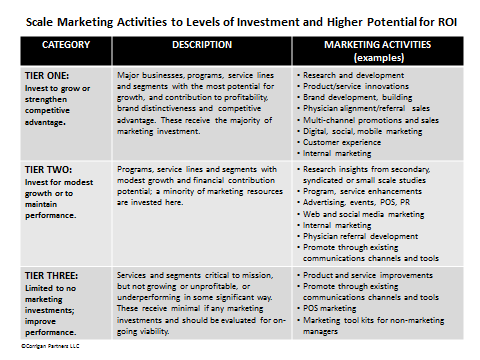 We’ve all been there. That place where we’re executing carefully crafted marketing plans, launching highly targeted and creative strategies, balancing both the over-stressed marketing team’s time and the under-resourced budget to make it all work when someone (e.g., administrator, doctor, service line leader) marches in with the mar
We’ve all been there. That place where we’re executing carefully crafted marketing plans, launching highly targeted and creative strategies, balancing both the over-stressed marketing team’s time and the under-resourced budget to make it all work when someone (e.g., administrator, doctor, service line leader) marches in with the mar
 We’ve all been there. That place where we’re executing carefully crafted marketing plans, launching highly targeted and creative strategies, balancing both the over-stressed marketing team’s time and the under-resourced budget to make it all work when someone (e.g., administrator, doctor, service line leader) marches in with the marketing demand du jour. Without a methodology for focusing activities and budgets on strategy-critical projects with the best potential for return on investment, every new demand takes on equal importance and, in the end, sabotages marketing performance.
We’ve all been there. That place where we’re executing carefully crafted marketing plans, launching highly targeted and creative strategies, balancing both the over-stressed marketing team’s time and the under-resourced budget to make it all work when someone (e.g., administrator, doctor, service line leader) marches in with the marketing demand du jour. Without a methodology for focusing activities and budgets on strategy-critical projects with the best potential for return on investment, every new demand takes on equal importance and, in the end, sabotages marketing performance.
Marketing resource allocation planning is the process of determining how returns on marketing investments are optimized. It’s a multi-dimensional decision process encompassing priority services, markets and segments, the marketing mix, and marketing operations and infrastructure investments.
Part two of this series (Focus Healthcare Marketing Investments to Improve Business Performance) described the first decision point – determining those programs, products, markets, segments and initiatives with the greatest potential for growth and ROI. Once the decision of what programs and service lines to grow has been made, you will then need to determine how time and budget dollars are allocated against the marketing mix.
Investment considerations that come into play at this point include:
- Research and development to build, expand and enhance the mix of service offerings
- Service line planning, clinical program development and patient care experience design
- Building brand awareness and stimulating demand in target customer segments
- Cultivating and strengthening access channels, physician relations and referrals
- Sales, third party contracting and pricing
- Advertising, promotions, marketing events and co-marketing partnerships
- Digital, social and mobile strategies and tactics
Marketing goals and strategy decisions should clearly guide these choices. The secret to success in marketing resource allocation is to know where investments return the biggest bang. Consumer influenced or directed services such as bariatric surgery, plastic surgery or sports marketing require more investment in direct consumer marketing, events marketing and call center support; services and procedures influenced more by physician referrals should be more heavily invested in sales, physician relations and new clinical program development.
SCALING ACTIVITIES TO INVESTMENTS
The scope and scale of marketing activities should be matched to investment levels and expected return on investment. In the example below, Tier One priorities (those most important to strategic and financial goals) receive the majority of marketing resources whereas activities and resources for Tiers Two and Three (those with modest to no return on investment potential) are scaled back considerably.
This may seem like a no-brainer but too often, the marketing team’s time and budget are compromised by squeaky-wheels, pet projects and deep-seated needs to keep everyone happy. (I think the misguided concept of ‘internal customers’ is also to blame, but that’s an entirely different post to write).
CRITICAL QUESTIONS TO ANSWER
- For Tier One initiatives, do we have adequate research and market intelligence to discern strategies and methods to more effectively attract consumers, increase physician referrals and move volume and market share from competitors? What additional information do we need?
- By service line, what segments are most attractive in terms of growth and profitability? How are those segments likely to be influenced (e.g. consumer marketing, physician referral development, program design, hours of operation, etc.)?
- What improvements/innovations at the service interface (e.g. scheduling, registration, access, patient navigation, web appointments, MD hotlines, etc.) differentiate and add value? What do we invest to create these programs?
- How can we leverage existing communications channels and tools to provide effective but lower investment support to lower tier programs? Should we provide tools, templates and information to program managers to support their marketing efforts?
- Do we have an adequate balance of activities and investments across research, product development, web, advertising and sales activities?
- How will we track the effectiveness of these initiatives and when do we regroup to change course?
- What marketing constraints, risks, etc. exist and how will those be addressed?
- How will we gain consensus for resource allocation decisions and cultivate support for that focus?
Gaining consensus is critical to keeping the organization focused on the marketing plan and investment decisions. Not that every bright shining object can or should be ignored – some may very well offer significant opportunities – but distractions can be minimized. The keys to effective marketing management are the discipline of focused execution, ability to discern when course corrections should be made, and capacity to seize new on-strategy opportunities.
In part four, I’ll discuss investments to build marketing infrastructure and capabilities.








